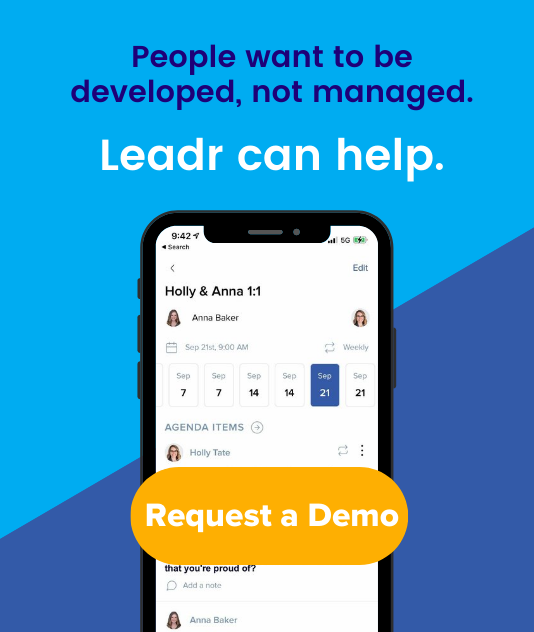Quiet Quitting - a Threat or an Opportunity?
Before you assume every Gen Z employee on your team is actively quiet quitting, let’s consider the opportunity this offers leaders to open communication lines, encourage a culture of feedback, and consider implementing more personalized development.
First off, what is quiet quitting?
Quiet quitting is nothing new. Long before the buzzword quiet quitting came along, there was coasting, doing the bare minimum, and disengagement. Since the beginning of time, disengaged workers have shown up for work, skated by, and gone home for the day.
We’re always quoting Gallup’s research that the manager alone accounts for 70% of the variance in team engagement. In fact, this data is precisely why Leadr exists.
So why are we seeing this rise in disengagement as something new?
Why Is Quiet Quitting Happening Now?
There are a number of reasons why people are voicing their active lack of engagement.
- COVID-19 caused everyone to reflect on their career choices
- The global health crisis also gave people the courage or freedom to voice these concerns, changes, and thoughts around the workplace
- Employee needs are changing as Gen Z becomes a higher percentage of the workforce
- These factors all gave employees the feeling that they had upper hand as The Great Resignation swept the nation, so why not speak up?
So it’s not that employee engagement is a new problem. It’s that the conditions are primed for discussing engagement from the employee’s point of view.
If we’re wise, we will listen to what they’re telling us.
How is the Quiet Quitting Phenomenon Your Biggest Leadership opportunity?
Lucky for you, this opens the conversation to ask your employees how engaged they are at work and to fix the problem if there is one.
This isn’t to say that all of the responsibility falls on the leader. There will always be people who just aren’t the right fit for your organization.
But let’s assume you’ve hired the right people who are motivated to grow, develop, and drive your mission. If these team members are disengaged, it’s not because they lack the passion, it’s because they aren’t being resourced well.
So how can we use quiet quitting to our advantage?
1. Implement 1:1 meetings to build trust
Trust isn’t built overnight, but while the conversation about engagement is front and center, use it to your advantage. Show your team members you care about their development and engagement by implementing weekly 1:1s. Notice I said weekly. If you’re only inviting your direct reports to 1:1s when there’s a problem, are you really invested in them or just going for a quick fix?
In these meetings, be sure you remove distractions, create an agenda, and tailor each one-on-one meeting to the individual employee. More 1:1 meeting tips here.
Do you treat 1:1s as something to cross off the list and rush through them fixated only on priorities and problems. Or do you come with intentionality, acknowledging the person's accomplishments, focusing on providing clarity, and investing in their growth as a person and professional?
Your input directly impacts the output.
The one question you should always ask in 1:1? A care question. Think:
- What goals do you have front of mind this week?
- How are you taking time to recharge this week?
- Is there an area of growth I can help you in right now?
- Do you have the resources you need to thrive in your role?
It’s ok if it’s repetitive as long as it's meeting a need. This is true development.
2. Offer opportunities for growth
Our SVP of Growth, Holly Tate, tells a powerful story about what she learned from working with a Gen Z intern.
Essentially, she realized,
“I was leading like a Millennial. I’m the leader. Here is the directive. We can collaborate and coordinate.
What he was expecting was for me to give him the problem that I needed to have solved and for him to come up with the solution. I’m there to mentor and guide and support.”
When we approach leadership like a coach, rather than a manager, growth opportunities are endless. If your employees are hungry to learn and invested in your mission, what more could you want? These are your future leaders. Invest in their growth. More on leadership development ideas here.
3. Open and maintain a two-way feedback loop
If there’s one thing we’ve learned from quiet quitting, it’s that employees are finding their voice in a new way. Use this to your benefit by opening the door for feedback. These conversations shouldn’t always be about performance, though they can be.
Research tells us that 90% of employees would prefer that their manager address learning opportunities and mistakes in real-time, not during an annual review only.
So feel free to go there. In fact, I encourage you to.
The goal of feedback is to help encourage or develop skills and behaviors. So instead of waiting for an annual performance review, make development conversations a part of your weekly meeting rhythm.
Quiet quitting is nothing new, and it’s nothing to be afraid of if you’re investing in your people well…for the most part.
If you’re doing all of the right things as a leader and are still struggling with an employee who doesn’t seem engaged, it could be time for a hard conversation. We’ve outlined the process of an effective performance improvement plant (PiP) along with a free PiP template here.
Hard conversations are never fun, but putting the organization’s mission first means having the right people in the right seat. Employee engagement is a two-way street.
What are your thoughts on quiet quitting?
Share in the comments.
Share this
You May Also Like
These Related Stories

Three Simple Strategies to Raising Up New Leaders On Your Team

Want Better 1:1s? Start With These 100 Questions






No Comments Yet
Let us know what you think